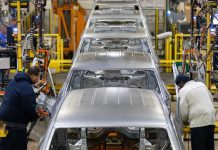In 1975, the United States took measures to improve the fuel economy of most vehicles by implementing the Corporate Average Fuel Economy (CAFE) standards. Congress recognized the need for regulations after the oil embargo of 1973 and therefore established these within the Energy Policy and Conservation Act of 1975. The standards have gradually risen with advancements in automotive technology, but in addition to increasingly prominent environmental concerns, the original purposes of relying less on foreign oil and having a more stable supply chain in the U.S. still stand.
A brief timeline of the CAFE rules is outlined below. 

1975: The U.S. Congress enacts the CAFE standards for passenger vehicles due to the shortage and extremely high price of oil after the 1973 embargo. The initial standard for model year 1978 vehicles is set at 18 miles per gallon, and the expectation is that any auto manufacturer that does not adhere to the guidelines by that time will be penalized.
1976: The CAFE standards are implemented for light trucks, setting the model year 1979 guidelines at 17.2 mpg for 2WD light trucks and 15.8 mpg for 4WD light trucks.
1978 – 1985: CAFE standards steadily rise. Passenger car rules increase from 18 mpg to 27.5 mpg. Rules for light trucks fluctuate up and down but remain around 19 mpg. In 1982, light truck manufacturers are given the option to either follow separate rules for 2WD and 4WD light trucks or have a combined standard. As of 1985, the combined standard is 19.5 mpg.
1986 – 1989: CAFE standards are slightly lowered to 26 mpg for passenger cars but remain at 20.5 for combined light trucks.
1990 – 2005: There are not many changes to the CAFE standards throughout the 1990’s and early 2000’s. The Clinton administration had moved to increase standards for light trucks, which was denied by Congress, who then placed a “freeze” on any modifications until 2000.
2005: The Bush administration starts looking into adjusting the standards. This is partially due to a 2002 report from the National Academy of Sciences projecting that the U.S. could save 2.7 million barrels of gasoline per day by taking stronger measures on increasing fuel efficiency. The standard for passenger cars will remain at 27 mpg until 2010, but the combined standard for light trucks is increased from 21 mpg in 2005 to 23.4 in 2010.
2007: As environmental concerns grow, the government gets more aggressive in the effort to increase fuel efficiency so Congress subsequently passes the Energy Independence and Security Act (EISA). After standards have remained steady for years, this Act increases them by around 40% at the time model year 2020 vehicles are being produced. The Act also requires emission standards be set for medium-duty and heavy-duty trucks.
2009: Then-president Barack Obama takes an even more aggressive approach, increasing the standard to 35.5 mpg by model year 2016. Guidelines are made stricter, requiring that averages must rise about 5% annually, roughly setting passenger cars at 39 mpg and light trucks at 30 mpg.
2010: The Obama administration proposes CAFE standards for medium-duty and heavy-duty trucks that would potentially save “500 million barrels of oil and 250 million metric tons of carbon dioxide emissions in the first five years.” Fuel economy improvements would be 20% for tractors and 10% for gasoline trucks and diesel trucks by model year 2018.
2018: President Donald Trump’s administration begins pushing the transformation of the CAFE standards into the Safer Affordable Fuel-Efficient (SAFE) Vehicles Rules, making them much more lenient and stating that these will save jobs, reduce vehicle accidents, and decrease costs. Opponents allege that the newly proposed standards will hurt the economy and cause significant damage to the environment. Several hearings are held regarding the proposed guidelines throughout late 2018.
June 2019: In a unique move, numerous automakers send a letter to Trump urging him to stop the possible rollback of the standards, stating that prices would rise and the environment would suffer. Trump plans to release decisions and outlooks in the summer.
Where It Stands Now: Ultimately, the future of the CAFE standards remains uncertain at the moment. Last week, Ryan Beene of Bloomberg reported that President Trump and his administration were delaying its “rule to weaken Obama-era automobile efficiency requirements” and have plans to revisit the topic in September.
However, it is important to note that numerous automakers have already stated they will continue on with the plan to meet the current CAFE standards and improve fuel efficiencies regardless if any changes are made or not.








